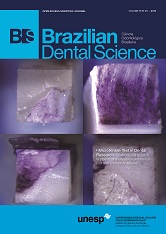Impact of prenatal protein-calorie malnutrition on the odontogenesis of wistar rats
DOI:
https://doi.org/10.14295/bds.2013.v16i3.921Resumo
Objective: This study aimed to determine changes in odontogenesis arising from prenatal and postnatal protein-calorie malnutrition. Materials and methods: Twelve adult Wistar rats were selected; 8 females and 4 males. The females were divided into two groups, one of which received a normoproteic diet (NG) and the other received a hypoproteic diet (HG). After the birth of the litters, 24 pups were randomly separated from each group. The animals were sacrificed, 12 at five-days old and 12 at eight-days old, and their jaws were subjected to histological preparation to obtain cuts of tooth germs. Forty-eight slides were selected that presented the germs properly cut (24 from each group), which were analyzed by microscopy and measured by a calibrated examiner. The differences between means were verified by the nonparametric Mann-Whitney test. Results: The results showed that at 5 days the differences in thickness of enamel and dentin were statistically significant between NG (84.08 ± 28.9 and 141.51 ± 33.2; p = 0.026) and HG (47.26 ± 43.8 and 91.19 ± 54.7; p = 0.006). At 8 days of life there were no significant differences between the groups. Conclusion: The results showed evidence of the impact of malnutrition on the thickness of dental tissues. It is suggested that further work is carried out in this line of research with more complex designs.
Downloads
Downloads
Publicado
Como Citar
Edição
Seção
Licença
TRANSFERÊNCIA DE DIREITOS AUTORAIS E DECLARAÇÃO DE RESPONSABILIDADE
Toda a propriedade de direitos autorais do artigo "____________________________________________________________________" é transferido do autor(es) para a CIÊNCIA ODONTOLÓGICA BRASILEIRA, no caso do trabalho ser publicado. O artigo não foi publicado em outro lugar e não foi submetido simultaneamente para publicação em outra revista.
Vimos por meio deste, atestar que trabalho é original e não apresenta dados manipulados, fraude ou plágio. Fizemos contribuição científica significativa para o estudo e estamos cientes dos dados apresentados e de acordo com a versão final do artigo. Assumimos total responsabilidade pelos aspectos éticos do estudo.
Este texto deve ser impresso e assinado por todos os autores. A versão digitalizada deverá ser apresentada como arquivo suplementar durante o processo de submissão.




























